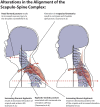Overlapping, Masquerading, and Causative Cervical Spine and Shoulder Pathology: A Systematic Review
- PMID: 32206519
- PMCID: PMC7076593
- DOI: 10.1177/2192568218822536
Overlapping, Masquerading, and Causative Cervical Spine and Shoulder Pathology: A Systematic Review
Abstract
Study design: Systematic review.
Objective: To assess the current literature regarding the relationship between the shoulder and the spine with regard to (1) overlapping pain pathways; (2) differentiating history, exam findings, and diagnostic findings; (3) concomitant pathology and optimal treatments; and (4) cervical spine-based etiology for shoulder problems.
Methods: A systematic literature search was performed according to the guidelines set forth by the Cochrane Collaboration. Studies were included if they examined the clinical, anatomical, or physiological overlap between the shoulder and cervical spine. Two reviewers screened and selected full texts for inclusion according to the objectives of the study. Quality of evidence was graded using OCEBM (Oxford Center for Evidence Based Medicine) and MINORS (Methodological Index for Nonrandomized Studies) scores.
Results: Out of 477 references screened, 76 articles were included for review and grouped into 4 main sections (overlapping pain pathways, differentiating exam findings, concomitant/masquerading pathology, and cervical spine-based etiology of shoulder pathology). There is evidence to suggest cervical spine pathology may cause shoulder pain and that shoulder pathology may cause neck pain. Specific examination tests used to differentiate shoulder and spine pathology are critical as imaging studies may be misleading. Diagnostic injections can be useful to confirm sources of pain as well as predicting the success of surgery in both the shoulder and the spine. There is limited evidence to suggest alterations in the relationship between the spine and the scapula may predispose to shoulder impingement or rotator cuff tears. Moreover, cervical neurological lesions may predispose patients to developing rotator cuff tears. The decision to proceed with shoulder or spine surgery first should be delineated with careful examination and the use of shoulder and spine diagnostic injections.
Conclusion: Shoulder and spine pathology commonly overlap. Knowledge of anatomy, pain referral patterns, shoulder kinematics, and examination techniques are invaluable to the clinician in making an appropriate diagnosis and guiding treatment. In this review, we present an algorithm for the identification and treatment of shoulder and cervical spine pathology.
Keywords: cervical spine pain; exam; radiculopathy; rotator cuff tear; shoulder pain; suprascapular neuropathy.
© The Author(s) 2019.
Conflict of interest statement
Declaration of Conflicting Interests: The author(s) declared no potential conflicts of interest with respect to the research, authorship, and/or publication of this article.
Figures




References
-
- Bokshan SL, DePasse JM, Eltorai AE, Paxton ES, Green A, Daniels AH. An evidence-based approach to differentiating the cause of shoulder and cervical spine pain. Am J Med. 2016;129:913–918. doi:10.1016/j.amjmed.2016.04.023 - PubMed
-
- Throckmorton TQ, Kraemer P, Kuhn JE, Sasso RC. Differentiating cervical spine and shoulder pathology: common disorders and key points of evaluation and treatment. Instr Course Lect. 2014;63:401–408. - PubMed
-
- Wilson C. Rotator cuff versus cervical spine: making the diagnosis. Nurse Pract. 2005;30:44–46, 48–50. - PubMed
-
- Zhang AL, Theologis AA, Tay B, Feeley BT. The association between cervical spine pathology and rotator cuff dysfunction. J Spinal Disord Tech. 2015;28:E206–E211. - PubMed
Publication types
LinkOut - more resources
Full Text Sources

